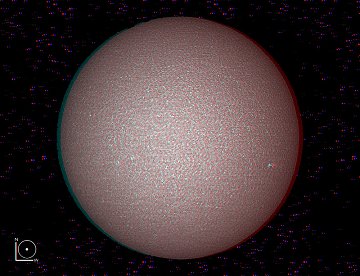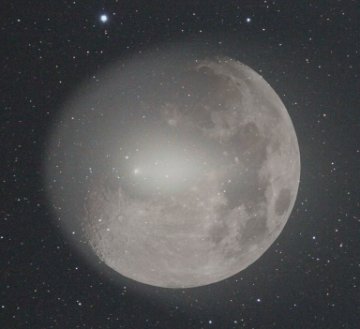 Where's Saturn? Is that a UFO--or the ISS? What's the name of that star? Get the answers from mySKY--a fun new astronomy helper from Meade. Where's Saturn? Is that a UFO--or the ISS? What's the name of that star? Get the answers from mySKY--a fun new astronomy helper from Meade. MARS DOUBLES IN BRIGHTNESS: During the past month, Mars has doubled in brightness and now it is putting on a nice show for backyard stargazers. A good night to look is Nov. 26th when Mars has an eye-catching close encounter with the Moon: full story. 3D SOLAR MINIMUM: The solar cycle is at low ebb; now is the time of "solar minimum." But even when the sun is blank and quiet, it can still leap out at you. Put on your 3D glasses and regard the following: 
"In 3D, the silent sun comes alive," says Greg Piepol of Rockville, Maryland, who created the anaglyph by combining images he captured through his Coronado SolarMax90. If you don't have 3D glasses, he advises, "a pair of red and blue astronomical filters will work, too." Click here for more 3D! COMET 17P/HOLMES: "Tonight the Moon was so bright it made Comet Holmes difficult to see with the unaided eye," reports Günther Strauch of Borken, Germany. "I decided to make this composite photo of the Moon and comet both shot to the same scale with my Canon 20D." 
His image shows the main reason why exploding Comet Holmes is fading from view: it is spread out and increasingly dilute. Bright moonlight only makes matters worse. Indeed, the comet may become very difficult to see in the nights ahead as the Moon becomes full on Saturday, Nov. 24th. Solution: use a backyard telescope to pierce the glare. With the assistance of a finderscope, the comet remains easy to locate in the constellation Perseus right beside the bright star Mirfak: sky map. Comet 17P/Holmes Photo Gallery
[Interactive World Map of Comet Photos]
[sky map] [ephemeris] [3D orbit] [Night Sky Cameras] | 
